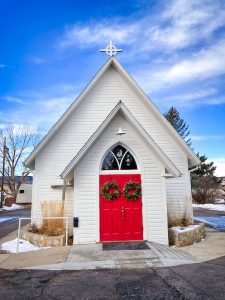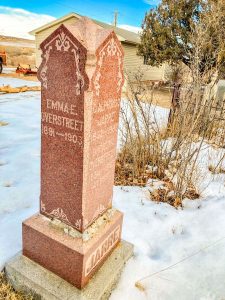St. Philip in the Field Church at Bear Canon
Article and photos by Joe Gschwendtner


The chapel at St. Philip in the Field is nicely “guarded” by the souls and remains of the many men and women who founded it.
Precisely 150 years ago, ranchers on West Plum Creek acted on a need for their own church home in Bear Canon. Newton S. Grout, a former Union Army drummer, was chosen to lead the 1872 construction effort. He began by demolishing a primitive log schoolhouse on the site.
Originally from Maine, Grout designed the chapel in the image of his own (Carpenter-Gothic style) boyhood church. Bear Canon Cemetery, named for the bears that allegedly once roamed the area, begun several years earlier, enveloped the holy construction project from the outset.
There was no shortage of local labor, but costs for the building’s finer, internal flourishes stalled the project out until 1884. Even so, not long after the project’s resumption, local hucksters managed to swindle a good chunk of the newly-raised funds to complete the church. It wasn’t until 1887 that Episcopal Bishop Spaulding secured final funding for the remaining work effort. To assure completion, he charged local parishioners William Curtis and John Harris, himself a carpenter, with oversight.
Finished in 1888, and small enough to be called a chapel, the 22’ x 30’ structure is striking for its simplistic external beauty and delicate details of the interior. Harris’ woodworking talent manifests itself nicely within the finish work done on the altar, vestibule, pews, chancel, sanctuary, sacristy and communion rail. Though the chapel’s location is well off the road and tree-enshrouded, it received the honor of being placed on the National Register of Historic Places in 1973, as did Bear Canon Cemetery.
There are some 1,650 graves in the surrounding graveyard. Its first two entrants were J. G. Lapham and a Mr. Wirtz. Lapham died from the impact of a horse fall, and almost simultaneously Wirtz was struck down by lightning. Many more sad tales and early deaths would come.

This obelisk pays homage to three unusual lives steeped in history from two centuries ago.
One of the very worst was the death of Christina Overstreet, Alphonse Jarre’s widow who had remarried John Overstreet, a young cowboy from Missouri. Their daughter, Emma, was only 3 years old when her mom died. A mere 10 years later, Emma died at age 13. Alphonse, Christina and Emma’s graves sit beneath a marble obelisk on the northwest periphery. Country-western musician Juni Fisher, who uncovered the history of her great grandfather (Overstreet), memorialized the agony of their lives on her “Gone for Colorado” album.
I attended the first service of 2022 at the chapel, finding the experience richer than anticipated. Vicar Janet Fullmer an attorney having moved on to a higher authority than the law, and her husband, Ron, delivered the service, which was also broadcast on Zoom. On that day, with the season’s first snow settled on the foothills, buttes, mesas, surrounding farms and ranches, the landscape was out of a Currier & Ives Christmas card. Afterward, the Fullmers reconvened in the annex behind the church with shortbread and coffee for the parishioners – likely just as it was done 150 years earlier.
Need a place to count your blessings on Sunday? St. Philip in the Field has some pew space still available. Of course, so does the cemetery.